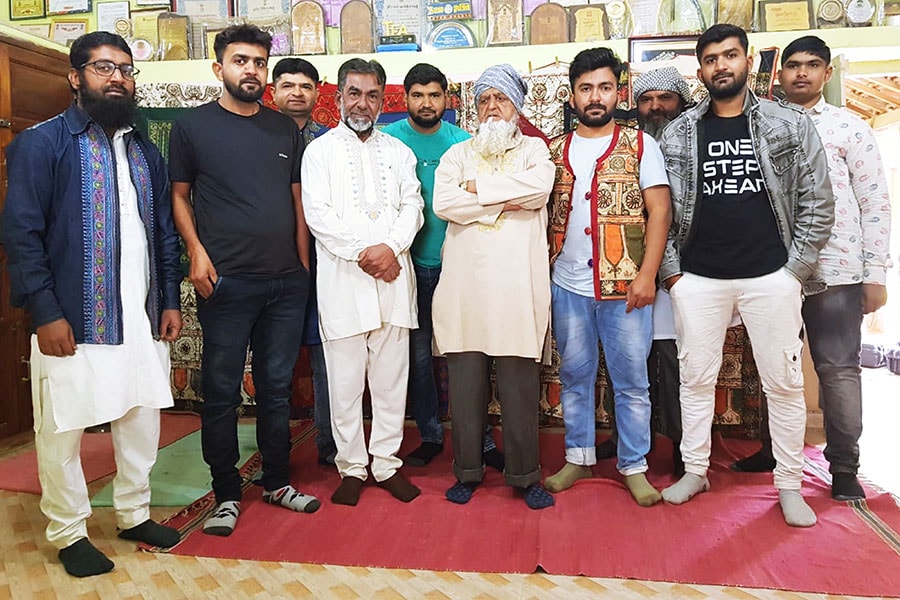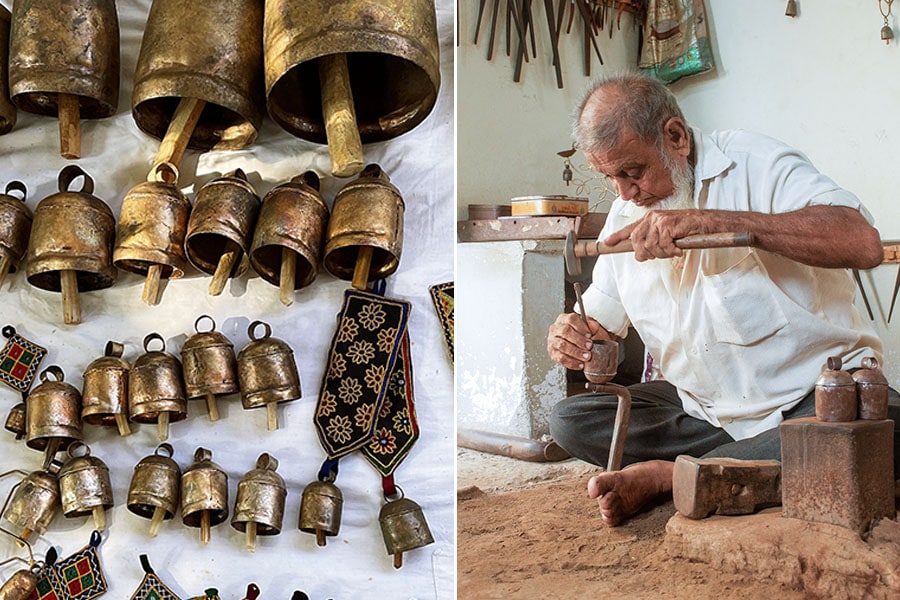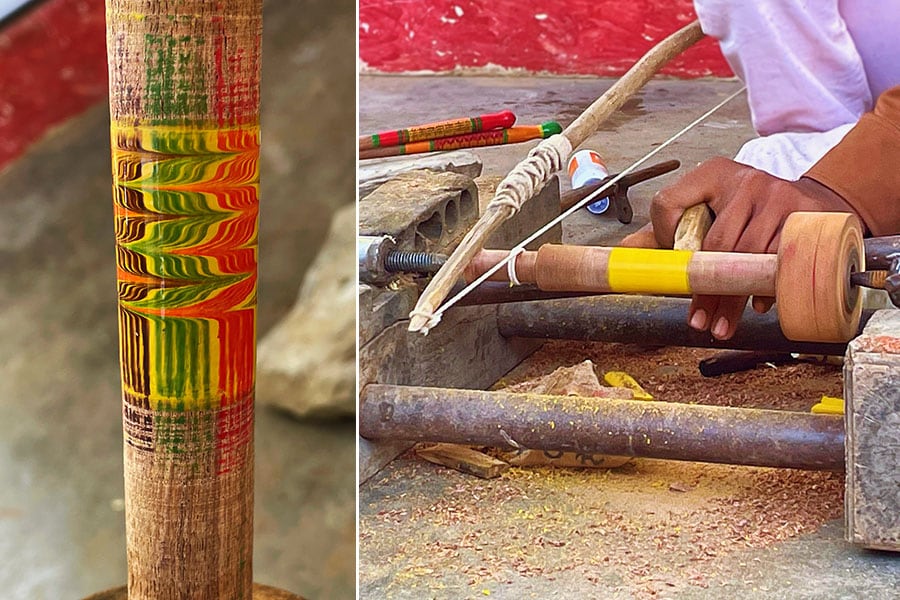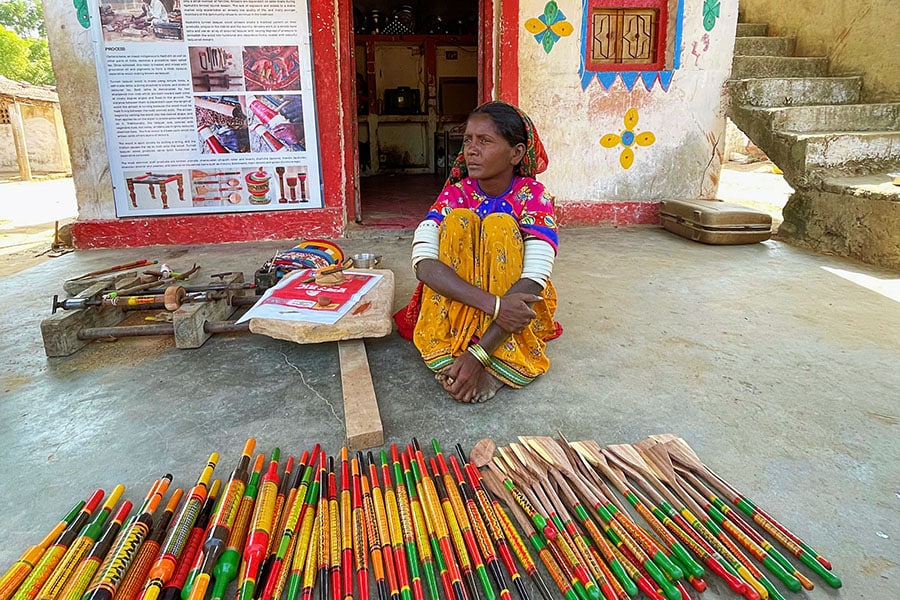Here, the air hums with the rhythmic clanks of copper hammers shaping exquisite crafts, sunlight dances on intricate Rogan paintings and lacquerware gleams with stories whispered through generations.
Along a dusty village lane, with sun-baked mud dwellings rising on either side, each doorway framed by a riot of colour, a wrought-iron gate painted a sombre black stands like a sentinel, with a rogue vine of bougainvillaea, like splashes of forbidden paint, trespassing from the next yard. Steeped in art, this house resonates with the echo of four centuries, where the Khatri family has held aloft the torch of Rogan painting, India"s sole inheritor of this award-winning tradition.
“In Persian, the term Rogan signifies oil-based," says Abdul Gafur Khatri (58), recipient of the Padma Shri award, eight state-level awards, five national awards, and even an international designer honour, about this art form that can be traced back to Iran. “Hailing from Iran, my family relocated to India almost four hundred years ago. Over time, we managed to uniquely tailor the Rogan art form, making it a distinctive specialty of Nirona. We proudly stand as the sole guardians of keeping the Rogan art alive for eight generations," he adds.
Traditionally, the legacy of the Rogan art was exclusively passed down to male members of the family. “However, in the new age, both my brother Sumar Daud Khatri (43) and I now supervise the village studio. This creative space is operated by a team of five artisans, including one woman." Gafur has also been teaching Rogan to village women, ensuring this art form keeps on kicking.
The making of a Rogan painting is an intricate process. Gafur points out the castor oil that undergoes a 12-hour boiling process, followed by its discharge into cold water, resulting in the formation of the gummy residue known as Rogan. Further, safflower and linseed oils are occasionally incorporated. To produce a spectrum of colours, this mixture is blended with stone dyes and a binding agent. The painting technique is equally fascinating. Gafur places a small amount of paint on his left palm, mixes it with his right index finger, then takes a 6-inch metal stick, dips it into the castor oil paint, and skilfully draws beautiful floral designs on a navy-blue cloth. The predominant themes in Rogan"s designs revolve around floral or geometric patterns, in yellow, red, pink, and blue.
Gafur shows us a variety of pre-painted Rogan designs. Those in his workshop are glass framed, while the ones in the backyard are in the process of drying on wooden cots. Gesturing towards one, he says, "My personal favourite is the "Tree of Life," a sentiment shared by Prime Minister Narendra Modi. He presented this exquisite design to Barack Obama during his presidency. You can commission this rare and beautiful artwork to be depicted on sarees, skirts, handbags, tablecloths, wall hangings, or even curtains."
He adds, “Once confined to the domain of bridal fashion, the local Rogan couture scene has undergone a makeover, now embracing all kinds of attires. The Rogan magic has broken free from exclusivity now, everyone can get their hands on it, whether you want it on your bedspreads or your ghagras (long skirts)."
![]() On the left - Samples of Copper Bell art. On the right - Artist Husen Sidhik working on a bell
On the left - Samples of Copper Bell art. On the right - Artist Husen Sidhik working on a bell
It’s not just Rogan painting that stands out in Nirona. A short stroll from the Khatri residence, at the copper studio of Husen Sidhik, a narrow passage, scented with the faint metallic tang of copper, leads to a porch bathed in the warm glow of copper art. Gentle chimes hum in the air, mingling with the rhythmic clinking of tools inside the studio. With calloused hands caressing a bell, Sidhik (76) explains, “The sound of the bell varies based on our hammering technique, so we need to consider the desired sound before crafting the bell. We create three different sounds in one bell to call buffaloes, cows, camels, lambs, and various other animals."
It’s a melodious affair that binds two countries. “The melodic echoes of bell chimes revive the timeless love once shared by India and Pakistan when pastoral communities thrived without boundaries. Back then, Gujarat"s indigenous nomads and tribal ranchers, known as Maldharis, freely roamed alongside their cattle and livestock before Partition," says Sidhik. “Despite the tragic conclusion of that love story, with boundaries drawn and villages relocated, the enduring passion for art and culture persevered. And the craft of making copper bells, an art form originating in Sindh (now Pakistan), continues to thrive in villages near the border."
Nirona’s artisans have seamlessly melded diverse art forms from across borders with Kutchi traditions, says Anuja Agarwal, managing director of Evoke Experiences, which organises Rann Utsav every year from November to March. Besides stay packages in the tent city, the festival includes cultural programmes and handcrafted arts from nearby villages, introducing the Kutchi tradition to people, as well as visits to the villages. “Within our Rann Utsav premises, we also provide platforms for these artisans to showcase their craftsmanship, featuring an array of locally sourced items, including reclaimed copper artwork and other handcrafted arts," she adds.
At Sidhik"s workshop, his brow furrowed in concentration, a fiery ballet dances with hammer and copper. Sparks flow like fireflies, mirroring the rhythmic symphony of clinking chisels and hissing torches wielded by other artisans. With swift, practised swings, the hammer sculpts its voice, and with his dexterity, forged in flame and sweat and pride etched in his wrinkles, he transforms a humble wedge into a sybaritic bell. In a show that lasted mere minutes, he has crafted a masterpiece without a hint of welding, just some skilful interlocking.
Sidhik, who has been making bells since the age of 12, receives assistance from his son Umar (43) and nephew Salim Husen (26). Within the luhar (blacksmith) community, each copper bell is recognised by its original name, often reflecting its function, size, or local significance. Names like Do Dingla, Chota Paila, and Paila Dingla resonate in the workshop. The Sidhiks" repertoire, however, extends beyond bells, encompassing a diverse range of creations such as bell chimes, candleholders, decor, summers, Saregama, morchangs, and even bell xylophones.
"Back in the day, we only had sweet, medium, and bitter sounds," reveals Faruk, Husen"s grandson. According to Faruk, a whole universe can be cooked up from a sound recipe. Tired of the same old tunes, Husen dared to venture into the uncharted territory of new sounds. Lo and behold, the Sidhiks birthed their very own musical scale—the SaReGaMaPaDhaNiSa bells, inspired by the myriad sounds they discovered.
Sidhik also underscores the sustainability aspect of his craft. "We upcycle discarded iron from damaged plates and cars to create copper art. Waste iron undergoes a transformative process in a thermally insulated kiln, exposed to burning charcoal until it metamorphoses into a flat surface. Our copper art ensemble is a testament to environmental consciousness, crafted entirely from natural materials like mud and Prosopis juliflora wood for the clapper."
Umar adds that their family has lived in Nirona for over seven generations, drawn by its abundance of cattle and the opportunity to continue their unique craft—creating intricate, hand-carved copper bells. “We are the sole artisans who specialise in this traditional art form by crafting carved bells to produce a one-of-a-kind piece. Our dedication to the craft is evident in the time invested." While the smallest bell takes a mere 3 hours to complete, larger creations require meticulous attention and nearly 20 days of work. This translates to a range of prices, starting from Rs 50 and reaching up to Rs 20,000, reflecting the time and skill poured into each piece, he says. Faruk chimes in, “We are setting our sights on international markets and will soon make our items available online."
![]() On the left - Beautiful details of lacquer art. On the right - An artisan in the middle of lacquer making
On the left - Beautiful details of lacquer art. On the right - An artisan in the middle of lacquer making
The tour of this art hub of Kutch culminates at the humble abode of Vaghavalabhai Khamiya, a master artisan hailing from the Wada (or Vadha) tribe. “Nirona," Khamiya says, originates from "Niro-Vadha", meaning "place of lumbermen and wood carvers". It was in this very name that he saw the essence of his people and their enduring legacy to the art of lacquerwork. Sunlight smears his workspace, while laughter and chatter dings as his family gathers in the front yard. Beneath a leafy canopy, they work with the rhythm of nature. Their nimble hands, guided by generations of knowledge, transform wood into lacquer using only rudimentary tools. Their time-honoured techniques and tools, simple yet effective, leave no trace, respecting the earth that provides them with materials. Every creation emerging from this sustainable endeavour infuses a hint of natural beauty and mindful purpose into their everyday routines.
Khamiya says, “Before the India-Pakistan Partition, the hamlets of Nirona and Bhirandiayara in Sindh resonated with the lacquer technique. This Kutchi legacy, handed down through generations, accompanied migrating families, with their handcrafted tools serving as the embodiment of a living tradition. Shellac, a resin retrieved from the lac insect thriving on Indian forest trees, forms the heart of this art. After careful treatment, it liquefies, becoming a brush-on colourant and wood finish. Remarkably, its white glow deepens to brown as it meets the air."
![]() From rolling pins to spatulas, lacquer art on sale in Nirona village
From rolling pins to spatulas, lacquer art on sale in Nirona village
He adds, “Lac resin becomes a palette, its colours mingling to breathe life into carved wooden forms. A woodworking vice grips the wood, while a manual belt undertones as it turns, ready for the artist"s touch. Guided by a manual lathe and a handful of chisels, we etch zigzag patterns that distinguish our work from the tapestry of traditional woodcraft."
The men breathe life into the wood, crafting cookware, toys, and ornate treasures. Meanwhile, the women play a vital role, gathering wood, preparing lac resin, crafting natural pigments with stones, and even concocting adhesives from babool tree gum. Each piece, a canvas for their collective artistry, bursts with the colourful zigzag motifs, a signature technique. To preserve its vibrant beauty, they use groundnut oil—a simple application that rekindles the lustre, making cherished pieces feel brand new again.
As Khamiya finishes demonstrating the making of a lacquer rolling pin, the cultural journey to Nirona concludes its last chapter. But the three elaborate tapestries—shades of Rogan, the cadence of copper, and the essence of lacquer echo within us for days after, and will assuredly find a place in your heart too.




